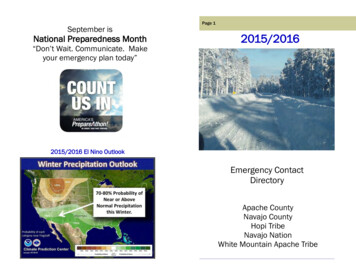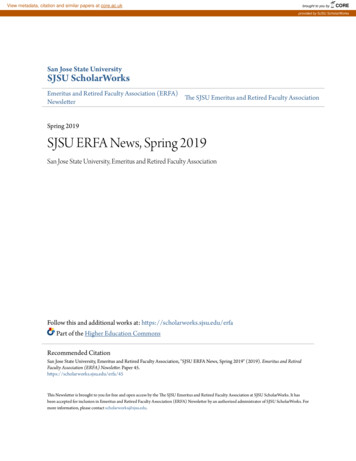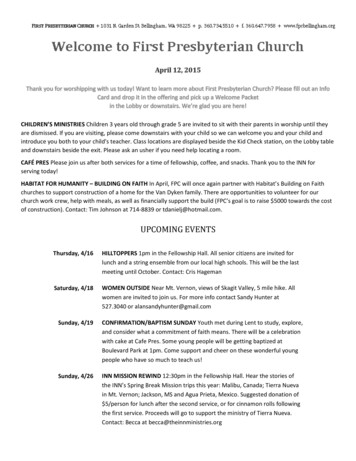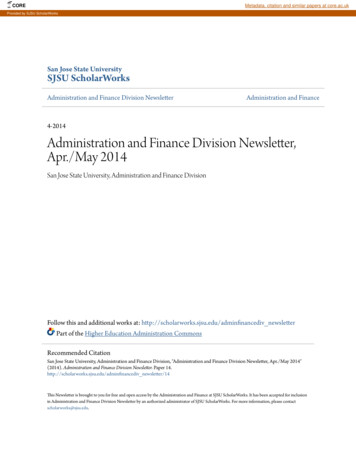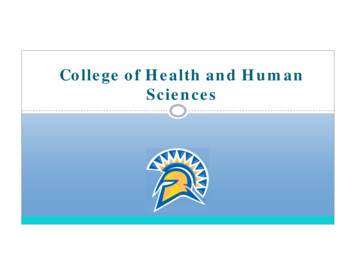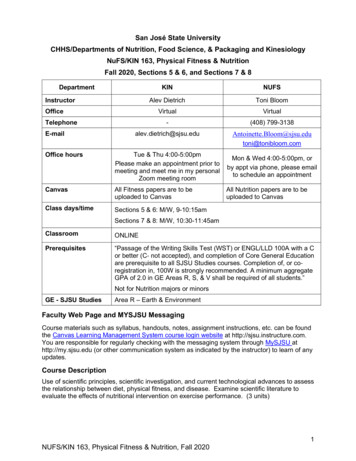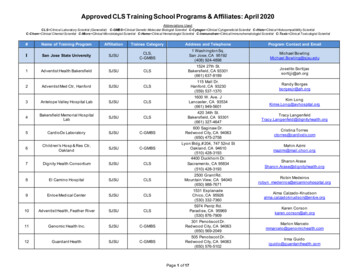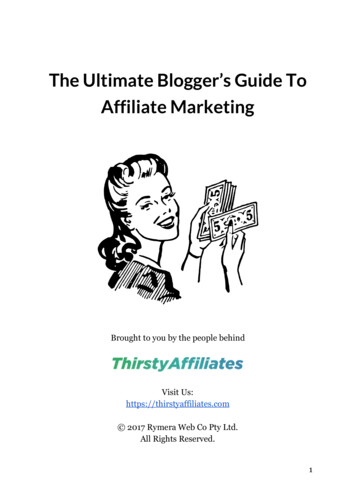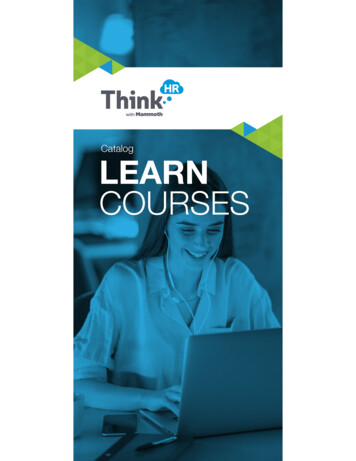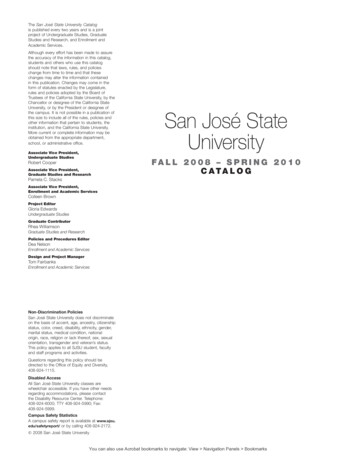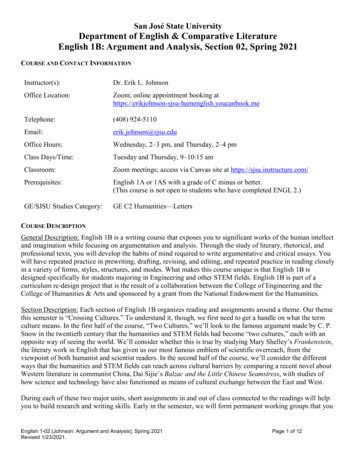
Transcription
San José State UniversityDepartment of English & Comparative LiteratureEnglish 1B: Argument and Analysis, Section 02, Spring 2021COURSE AND CONTACT INFORMATIONInstructor(s):Dr. Erik L. JohnsonOffice Location:Zoom; online appointment booking eTelephone:(408) 924-5110Email:erik.johnson@sjsu.eduOffice Hours:Wednesday, 2–3 pm, and Thursday, 2–4 pmClass Days/Time:Tuesday and Thursday, 9–10:15 amClassroom:Zoom meetings; access via Canvas site at https://sjsu.instructure.com/Prerequisites:English 1A or 1AS with a grade of C minus or better.(This course is not open to students who have completed ENGL 2.)GE/SJSU Studies Category:GE C2 Humanities—LettersCOURSE DESCRIPTIONGeneral Description: English 1B is a writing course that exposes you to significant works of the human intellectand imagination while focusing on argumentation and analysis. Through the study of literary, rhetorical, andprofessional texts, you will develop the habits of mind required to write argumentative and critical essays. Youwill have repeated practice in prewriting, drafting, revising, and editing, and repeated practice in reading closelyin a variety of forms, styles, structures, and modes. What makes this course unique is that English 1B isdesigned specifically for students majoring in Engineering and other STEM fields. English 1B is part of acurriculum re-design project that is the result of a collaboration between the College of Engineering and theCollege of Humanities & Arts and sponsored by a grant from the National Endowment for the Humanities.Section Description: Each section of English 1B organizes reading and assignments around a theme. Our themethis semester is “Crossing Cultures.” To understand it, though, we first need to get a handle on what the termculture means. In the first half of the course, “Two Cultures,” we’ll look to the famous argument made by C. P.Snow in the twentieth century that the humanities and STEM fields had become “two cultures,” each with anopposite way of seeing the world. We’ll consider whether this is true by studying Mary Shelley’s Frankenstein,the literary work in English that has given us our most famous emblem of scientific overreach, from theviewpoint of both humanist and scientist readers. In the second half of the course, we’ll consider the differentways that the humanities and STEM fields can reach across cultural barriers by comparing a recent novel aboutWestern literature in communist China, Dai Sijie’s Balzac and the Little Chinese Seamstress, with studies ofhow science and technology have also functioned as means of cultural exchange between the East and West.During each of these two major units, short assignments in and out of class connected to the readings will helpyou to build research and writing skills. Early in the semester, we will form permanent working groups that youEnglish 1-02 (Johnson: Argument and Analysis), Spring 2021Revised 1/23/2021.Page 1 of 12
will confer with regularly as we discuss readings and you review each other’s writing. At the end of each unit,you will produce two culminating assignments, one oral and collaborative—a group podcast episode in whichyou and your group members discuss sources you have been collecting regarding the current unit—and theother written and individual—a research essay building on the work you will have done in the mini-essaysassigned in each unit to address a larger question about STEM and the liberal arts in a global education.COURSE FORMATTechnology Intensive, Hybrid, and OnlineThis course will be conducted synchronously online (synchronously means, with regular live video meetings).The key software to be familiar with is Canvas (online platform for assignments, exams, text-based discussionforums, and up-to-date syllabus information) and Zoom (for video course sessions and office hour meetings).You will also need reliable Internet access and a computer with a webcam.You can join Zoom sessions through links in Canvas, but you will need the Zoom software installed. Forinstructions on installing and using Zoom, see the eCampus Zoom pages rces/zoom-for-students.phpFACULTY WEB PAGE AND MYSJSU MESSAGINGCourse materials such as syllabus, handouts, notes, and assignment instructions can be found on the CanvasLearning Management System course login website at http://sjsu.instructure.com. You are responsible forchecking your SJSU email regularly and for ensuring that you receive announcements posted to Canvas.For info on changing your notification preferences and viewing comments on Canvas, see the eCampus tutorialpages at /student resources/index.htmlEmailing erik.johnson@sjsu.edu is the best way to reach me. I usually respond to student emails within 24hours, but if you email me after 9 pm or on the weekend, I may not see your email until the next business day.You are always welcome in my office hours, which are student-centered time. You can book appointments e up to minutes before if a slot is open, or you can email meto set up meetings at other times.GE LEARNING OUTCOMES (GELOS)During this course, you will develop the skills needed to:1) Recognize how significant works illuminate enduring human concerns;2) Respond to such works by writing both research-based critical analyses and personal responses;3) Write clearly and effectively; and4) Recognize the role of diversity in culture and society.COURSE LEARNING OUTCOMES (CLOS)You will meet these general objectives by mastering specific techniques, including learning to:1) Develop and carry out research projects, and locate, evaluate, organize, and incorporate informationeffectively (from English department C2 course learning goals);2) Use a critical lens to read a variety of literary, rhetorical, and professional works of the human intellectand imagination;English 1-02 (Johnson: Argument and Analysis), Spring 2021Revised 1/23/2021.Page 2 of 12
3) Write clearly, effectively, and creatively, and adjust writing style appropriately to the content, thecontext, and the nature of the subject (from English department C2 course learning goals);4) Explain how a text both frames and is framed by a variety of critical lenses: cultural, historical, socioeconomic, political, and personal;5) Demonstrate how humanistic methods of reasoning and arguing can prepare students to meet the globalchallenges facing scientists and engineers.REQUIRED TEXTS/READINGSSkills Textbook:Johnston, Ian. Essays and Arguments: A Handbook for Writing Student Essays. Revised edition. Broadview.ISBN 978-1-55481-257-8.Assigned Literary Texts:Shelley, Mary. Frankenstein: Annotated for Scientists, Engineers, and Creators of All Kinds. MIT Press. ISBN978-0-262-53328-7. Also available as an open access (free!) ebook through the SJSU Library at nk/f/1cue0e3/01CALS ALMA51471735070002901Sijie, Dai. Balzac and the Little Chinese Seamstress: A Novel. Translated by Ina Rilke. Vintage.ISBN 978-0-385-72220-9.A Note about Texts:Additional short readings will be posted or linked on the Canvas site throughout the semester, including bothshort articles and essays and handouts with essay-writing advice.Literary texts, and in particular Frankenstein, are often available in multiple versions that differ significantly.Since we will need to refer to specific passages in our texts by page number and, in the case of Frankenstein,will also discuss the footnotes and essays targeted to engineers and scientists like yourselves in the MIT edition,it’s important to have access to works in the editions listed. Books are available for purchase or rental from theSpartan Bookstore. A free e-book of the MIT Frankenstein edition is available through the link above. If youare purchasing from third-party vendors, double-check the ISBN to make sure you are getting the right edition!Other technology requirements / equipment / materialYou will need stable Internet access and a computer that has a webcam and a microphone to participate inZoom discussions. Headphones are recommended; they help you concentrate and filter out background noise.You will also need hardware and software to record conversations with classmates in order to complete the oralassignments (two group podcast episodes) assigned for the course. Zoom can record a conversation, but youwill also want to install a program that allows you to edit recordings, like Garage Band (included on mostmodern Macs) or Adobe Audition (included in the Adobe Creative Cloud suite, which is free to San José Statestudents; see students/index.html for more info).You can borrow laptops, tablets, headphones, and other equipment from Student Computing Services for freeon a first-come, first-served basis. For details and to make a checkout appointment, see the IT EquipmentLoaning webpage at ipment-loaning/index.phpLibrary LiaisonPeggy Cabrera, peggy.cabrera@sjsu.eduEnglish 1-02 (Johnson: Argument and Analysis), Spring 2021Revised 1/23/2021.Page 3 of 12
COURSE REQUIREMENTS AND ASSIGNMENTSMini-essays #1, 2, and 3 (750 words each 2,250 words total): Three short essays assigned throughout thecourse will let you practice specific modes of critical and persuasive writing, including rhetorical analysis, closereading, and character analysis that draws on your personal experience to make a persuasive point. I encourageyou to build on and revise the work you do in these short essays when you are drafting the longer papers.Oral assignment #1, group podcast episode on uses of Frankenstein: During our “Two Cultures” unit, eachworking group will record a podcast episode of at least 20 minutes in which each team member presents anddiscusses an adaptation of Frankenstein or use of “Frankenstein” in public commentary that they have foundparticularly interesting. Your goal as a group is to organize this material in a logical way so that in the episodeyou all contribute to one overarching conversation. (You should discuss each team member’s source for about 4minutes.) Along with the episode recording, each group will also submit an outline that includes 100 or morewords describing and commenting on each “exhibit source” from the team member who picked it.Research essay #1, “Two Cultures” (1,500 words minimum): At the end of our first unit, you will write aresearch-based essay exploring the relationship between “humanistic” thought and science or technology bytaking Frankenstein and some adaptation or use of Frankenstein in contemporary culture that you have foundinteresting as a case study. Your essay should be at least 1,500 words and cite at least four credible sources fromoutside the syllabus, at least one of which must be an “exhibit” source and at least one of which must be an“argument” or “theory” source. (We will discuss source types in class.) As a pandemic accommodation, I amstructuring the course so that your first two mini-essays and unit podcast contribution can feed into andbe considered a “draft” of this assignment. You will also have a chance, though, to revise the essayfurther after receiving my comments for an improved grade.Oral assignment #2, group podcast episode on cross-cultural STEM or liberal arts education: During our“Bridging Cultures” unit, each working group will record a podcast episode of at least 20 minutes in which eachteam member presents and discusses a source about liberal arts or STEM education in a cross-cultural or globalcontext that provides an updated perspective on the issues raised by Balzac and the Little Chinese Seamstress.(For instance you might find a case study about liberal arts education in contemporary China, or you might findone about STEM programs geared toward international students in the United States.) Your goal as a group is toorganize this material in a logical way so that in the episode you all contribute to one overarching conversation.(You should discuss each team member’s source for about 4 minutes.) Along with the episode recording, eachgroup will also submit an outline that includes 100 or more words describing and evaluating each source fromthe team member who picked it.Research essay #2, “Bridging Cultures” (1,750 words minimum): At the end of our second unit, you will write aresearch-based essay making a specific recommendation about how STEM or liberal arts education shouldfunction in a global society, through reference to a case study you have found. Your essay should be at least1,750 words in length and cite at least four credible sources from outside the syllabus, at least one of whichmust be a “theory” source. (We will discuss source types in class.) As a pandemic accommodation, I amstructuring the course so that your third mini-essay and unit podcast contribution can feed into and serveas the initial basis of this final assignment. You will also conference with me about a draft version of theessay and produce a revision during the final weeks of the course.Culminating Activity (Portfolio): In place of a final examination, you will at the end of the course assemble aportfolio of your writing with a reflective statement of about 500–600 words discussing your growth as a writerduring the semester. We will hold portfolio prep workshops during the final weeks of class.English 1-02 (Johnson: Argument and Analysis), Spring 2021Revised 1/23/2021.Page 4 of 12
Classwork and Participation: In addition to the major assignments listed above, you should be prepared toattend class regularly and come prepared to participate with questions and comments about the days reading. Iwill occasionally collect and grade in-class exercises practicing specific writing and reading skills, and yourpeer reviews of group members’ essays will also factor into the participation grade.Success in this course is based on the expectation that students will spend, for each unit of credit, a minimum of45 hours over the length of the course (normally three hours per unit per week) for instruction, preparation andstudying, or other course related activities. In other words, you should expect to spend 9 hours a week on this 3unit course (2-1/12 hours in class and a little more than 6 hours on homework). If you calendar that amount oftime to spend on work outside of class each week, it will greatly improve your chances of success!GRADING INFORMATIONGrades will be numerical. The table below shows point to letter-grade correspondences and includes my generalstandards for assessing written work. “Plus” or “minus” grades meet the standards for a mark to a greater orlesser degree. Assignments will be posted with rubrics that include additional, assignment-specific criteria.GradeA plusAPoints970 to 1000930 to 969Percentage97 to 100%93 to 96.9%A minusB plusB900 to 929870 to 899830 to 86990 to 92.9%87 to 89.9%83 to 86.9%B minusC plusC800 to 829760 to 799730 to 75980 to 82.9%76 to 79.9%73 to 75.9%C minusD plusD700 to 729660 to 699630 to 65970 to 72.9%66 to 69.9%63 to 65.9%English 1-02 (Johnson: Argument and Analysis), Spring 2021Revised 1/23/2021.CriteriaWritten work marked “A” poses an original,provocative argument that is credibly supportedby appropriate evidence, makes a compelling casefor its significance, has a clear logicalorganization, and uses language and style in away that communicates not just the bare meaningbut creates a sense of voice or style.Work marked “B” poses a valid argument that iscredibly supported, makes a plausible case for itssignificance, has a clear logical organization, anduses language and style to communicate thestudent’s ideas effectively and without ambiguity.Work marked “C” meets the requirements of theassignment but shows significant weakness in onefundamental area—the argument may be unclearor insufficiently supported, its significance maynot be clearly or persuasively stated, the structuremay be illogical, or the language and style mayoccasionally obstruct meaning.Work marked “D” was clearly written by thestudent to address the assignment but showssignificant weakness in more than one of thefundamental areas listed above, or the use oflanguage and style frequently obstructs meaning.Page 5 of 12
GradeD minusFPoints600 to 629599 or belowPercentage60 to 62.9%59.9% or belowCriteriaWork marked “F” either does not meet therequirements of the assignment or reliessubstantially on work by others that is representedas the student’s own.Grading BreakdownAssignmentMini-essay #1: Rhetorical Analysis (minimum 750 words) *PointWeight(/1000)50Mini-essay #2: Close Reading (minimum 750 words) *50Mini-essay #3: Persuasive Writing: Character Analysis(minimum 750 words) *Oral Assignment 1: Group podcast episode on uses of Frankensteinwith outline (20 minutes, approximately 4 minutes of talking timeper group member; outline includes source overview with at least100 words of writing per group member)*Oral Assignment 2: Group podcast episode surveying sources onliberal arts and/or STEM education in a cross-cultural or globalcontext (20 minutes, approximately 4 minutes of talking time pergroup member; outline includes source overview with at least 100words of writing per group member)*Research Essay 1: Two Cultures (Frankenstein) unit(minimum 1,500 words)*Research Essay 2: Bridging Cultures (Balzac and the Little ChineseSeamstress) unit (minimum 1,750 words)*Reflective Statement and Final Portfolio75100GELOs andCLOs assessedGELO 3;CLOs 2, 3GELOs 2, 3;CLOs 2, 3, 4GELOs 2, 3, 4;CLOs 2, 3, 4, 5GELO 1;CLOs 1, 2, 4, 5125GELO 4;CLOs 1, 2, 5200GELOs 1, 2, 3;CLOs 1, 2, 3, 4GELOs 1, 2, 3, 4;CLOs 1, 3, 4, 5GELOs 2, 3;CLOs 3, 5GELOs 2, 3;CLOs 2, 3, 4GELOs 1, 4;CLOs 2, 3, 4, 522575In-class writing and exercises50Participation (including peer review activities)50* Major assignments. Point allocations notwithstanding, you must turn in each of the “major assignments”identified with an asterisk in order to complete the course and receive credit for the GE requirements.Late Work and Missed In-Class WorkIf you cannot meet the deadline for an assignment, email me requesting an extension as early as possible, but nolater than two days before the assignment is due, so that I have time to review and respond to the request. Outof-class assignments turned in one day or more after a listed deadline without an extension agreed to in writingwill be penalized a third of a letter grade for each calendar day (not business day) late. For example, a mark of85.0% (B) for a paper turned in one day late would drop to 82.0% (B–), two days late to 79.0 (C ), and so on.English 1-02 (Johnson: Argument and Analysis), Spring 2021Revised 1/23/2021.Page 6 of 12
Missed in-class writing cannot be made up. However, at the end of term I will drop your lowest classworkassignment grade. I will also occasionally announce extra credit assignments that will add to your total points inthis category, and these can help to recover missing points.CLASSROOM PROTOCOLRegular and active participation in class is expected. In a Zoom classroom, this means: You don’t need to have your video on all the time, but, unless you are having connection issues, you shouldturn it on when you are speaking for your group, and everyone should be ready to turn it on if asked. When your video is not on, your Zoom account should display your name (not a screenname) and a profilepicture that represents you in some way (that can be a photo of yourself or any image that communicatessomething about you). For information on customizing your profile see the Zoom support page 203-Customizing-your-Profile We will use breakout rooms for brainstorming and other activities during discussion. You can leave thesebreakout rooms to return to the main session and ask questions. I will not drop into breakout rooms unlessasked, and I will give at least a 2-minute warning before ending breakout sessions. When peers are speaking in whole-group discussion, let them finish before starting to speak. If you havequestions or comments directly related to what they are saying, use the text chat to register them. Do also feelfree to use reaction signals to second colleague’s points (thumbs up, clapping hands, etc.) while they speak! Put away your cell phone or other mobile devices before class, and please close any applications that are notbeing used for class activities.In the first weeks, we’ll organize discussion groups that will work closely together throughout the semester.These groups will as peer review groups and on collaborative assignments, including .UNIVERSITY POLICIES AND RESOURCESAcademic Integrity: All work delivered in this course must be your own, produced specifically for this course,and produced specifically for the assignment in question. If you draw on the ideas or language of others inwritten work or presentations, you must, by University policy, specifically acknowledge your indebtedness. Ifyou have questions about the appropriate acknowledgment of sources, please review the library tutorial on howto avoid plagiarism at https://libguides.sjsu.edu/plagiarism or contact me. Recycling material from paperswritten for other courses, or even from earlier papers written for this course in later ones, is also not acceptableunless an assignment specifically asks you to do so. If you wish to write a paper on a similar topic to a paperyou have written before or using a similar set of sources, you are welcome to consult with me about ways ofadjusting or expanding the topic so that you can build on your prior work and still meet the course requirements.Accommodations: Presidential Directive 97-03 requires that students with disabilities requestingaccommodations register with the Accessible Education Center (AEC) to establish a record of their disability.The AEC will contact the instructor with details. If you need to discuss possible course adaptations oraccommodations, do make an appointment or visit my office hours as early in the semester as possible.Other Policy Information: Per University Policy S16-9 (http://www.sjsu.edu/senate/docs/S16-9.pdf), relevantuniversity policy concerning all courses, such as student responsibilities, academic integrity, accommodations,dropping and adding, consent for recording of class, etc. and available student services (e.g. learning assistance,counseling, and other resources) are listed on the Syllabus Information web page(http://www.sjsu.edu/gup/syllabusinfo), which is hosted by the Office of Undergraduate Education. Make sureto visit this page to review for official descriptions of these university policies and resources.English 1-02 (Johnson: Argument and Analysis), Spring 2021Revised 1/23/2021.Page 7 of 12
SUPPORT SERVICESIn addition to my office hours, English 1B students may find the following support services especially useful:SJSU Writing Center: The San José State University Writing Center offers a variety of resources to helpstudents become better writers, and all of its services are free for SJSU students. While we are online, theWriting Center offers drop-in tutoring by text chat for quick questions, scheduled 45-minute appointments viaZoom, and virtual workshops on topics like improving your sentence and paragraph stye, managing timeeffectively during essay exams, and making PowerPoint slides. For more information and to make anappointment or sign up for a workshop, see the website at http://www.sjsu.edu/writingcenter/SJSU Communication Center: The San José State University Communication Center is also available to helpstudents practice public speaking and general communication skills, through workshops and individual tutoring,including practicing and recording speeches. This is a great resource in preparing for oral assignments, becauseyou can make Zoom appointments for groups as well as individuals and can book up to 60 minutes ofcommunications tutoring per day! To make a Zoom appointment for communications tutoring, /index.htmlPeer Connections: Peer Connections, a campus-wide resource for mentoring and tutoring, strives to inspirestudents to develop their potential as independent learners while they learn to successfully navigate throughtheir university experience. You are encouraged to take advantage of their services which include coursecontent based tutoring, enhanced study and time management skills, more effective critical thinking strategies,decision-making and problem-solving abilities, and campus resource referrals.In addition to offering small group, individual, and drop-in tutoring for a number of undergraduate courses,consultation with mentors is available on an appointment basis. Workshops are offered on a wide variety oftopics including preparing for the Writing Skills Test (WST), improving your learning and memory, alleviatingprocrastination, and other related topics. All services are currently available online. Visit the Peer Connectionswebsite at http://peerconnections.sjsu.edu for more information.English 1-02 (Johnson: Argument and Analysis), Spring 2021Revised 1/23/2021.Page 8 of 12
English 1B-02 (Johnson): Argument and Analysis, Spring 2021 ScheduleThis schedule is subject to change with fair notice. Any changes will be announced during class meetings andvia Canvas. Assignments are due on 11:59 pm Pacific Time on the listed due date, unless otherwise stated.COURSE SCHEDULEWEEKDATETOPICS, READINGS, ASSIGNMENTS, DEADLINES1Thursday,January 28Course Introduction and OverviewIn-class: Read selections from Shelley, 1831 introduction to Frankenstein2Tuesday,February 2UNIT 1: STEM AND THE HUMANITIES AS “TWO CULTURES”Arguments from DefinitionRead, in Frankenstein: Doctorow, “I’ve Created a Monster! (And So CanYou),” pages 209–13; Nordmann, “Undisturbed by Reality: VictorFrankenstein’s Technoscientific Dream of Reason,” pages 223–28;Douglas, “The Bitter Aftertaste of Technical Sweetness,” pages 247–51.2Thursday,February 4Rhetorical Analysis and Effective AnnotationRead: C. P. Snow, “The Two Cultures” (selections on Canvas); MerriamWebster, “‘Frankenstein’ and ‘Frankenfood’: Creator or creation?: Givingnew life to a prefix” (link on Canvas); Johnston, Essays an Arguments 2.4–2.5.4 (pages 10–20).Monday,February 8Tuesday,February 9Topic proposal for mini-essay #1 due on CanvasThursday,February 11Inspectional Reading and Strategies for Reading Books vs. ArticlesRead: Frankenstein, Vol. 1 (pages 1–69) — plan ahead to finish on time!!Monday,February 15Tuesday,February 16Mini-essay #1, Rhetorical Analysis, due on Canvas @ 11:59 pm4Thursday,February 18Close Reading versus Rhetorical AnalysisRead: Frankenstein, finish Vol. 2 (pages 100–125); Johnston, 8.4: WritingEssays about Fiction, pages 263–775Tuesday,February 23Arguments from ContextRead: Frankenstein, introduction by Robinson, pages xxxiii–xxxv; also,review the footnotes about science in Frankenstein, Vols. 1–2, and comeprepared to share thoughts about at least 2 of them.334Major Tools of Argument: Deduction, Induction, DefinitionRead: Johnston 2.6–2.8.4 (pages 20–33)Taking Notes on and Making Arguments about a Literary TextRead: Frankenstein, start Vol. 2 (pages 71–100); Johnston on focus versusthesis, 4.2.-4.3.1 (pages 66–79)English 1-02 (Johnson: Argument and Analysis), Spring 2021Revised 1/23/2021.Page 9 of 12
WEEKDATETOPICS, READINGS, ASSIGNMENTS, DEADLINESThursday,February 25Arguments from a Conceptual FrameworkRead: Frankenstein, start Vol. 3 (pages 127–54); Johnston 5.0, “ExplainingKey Terms” (pages 93–111).Monday,March 1Tuesday,March 2Mini-essay #2, Close Reading, due on Canvas @ 11:59 pm6Thursday,March 4Introduction to the Oral Assignments, Podcasting Tutorial 1Hands-on workshops on finding sources of different types, planning aproject, and recording an episode7Tuesday,March 9Theory Sources: Applying a Conceptual Framework from a SourceRead: Nagel, “What Is It Like to Be a Bat?” and Gopnik, “How AnimalsThink” (review of De Waal, Are We Smart Enough to Know How SmartAnimals Are?)7Thursday,March 11Podcasting Tutorial 2 (Editing) and Group WorkshopsHands-on workshop on editing a recording, group project planningMonday,March 15Oral project #1, Group podcast episodes on contemporary adaptationsand/or uses of Frankenstein, due on Canvas with outline8Tuesday,March 16Generating Research QuestionsRead: Johnston 6.0–6.5.1 on organizing an argument (pages 113–24)8Thursday,March 18Pre-Writing Toolkit for Combining Research and WritingBefore class: Listen to your peers’ podcasts, shared on CanvasFriday,March 19Tuesday,March 23Topic proposal for Research Essay #1 due on Canvas @ 11:59 pmThursday,March 25Writing with Sources: Quoting and Paraphrasing EffectivelyBefore class: Complete the plagiarism tutorial athttps://libguides.sjsu.edu/plagiarism/home-page (also linked on Canvas)Friday,March 26Research essay #1, Revision and expansion of mini-essays and/orpodcast material, due on Canvas @ 11:59 pm5699Using Sources: the BEAT TaxonomyRead: Finish Frankenstein, Vol. 3 (pages 154–93); review supplementaryessays and appendix, come with at least one essay annotated for discussionFrom Outlining to Drafting: Ordering ParagraphsBefore class: Expand your topic proposals to include at least three possibletopic sentences for body paragraphs; Read: Johnston on paragraph clusters,6.8–6.8.2 (pages 132–43), 6.8.4 (pages 147–49), 6.9 (pages 152–58)English 1-02 (Johnson: Argument and Analysis), Spring 2021Revised 1/23/2021.Page 10 of 12
WEEKDATETOPICS, READINGS, ASSIGNMENTS, DEADLINESMarch 29–April 2Tuesday,April 6SPRING BREAK: NO CLASSES!Thursday,April 8Using Personal Experience and Opinion in ArgumentRead: Sijie, Balzac, start Part 2 (pages 45–89)Friday,April 9OPTIONAL Revision of Research Essay #1 due @ 11:59 pm(No extensions!)11Tuesday,April 1
Revised edition. Broadview. ISBN 978-1-55481-257-8. Assigned Literary Texts: Shelley, Mary. Frankenstein: Annotated for Scientists, Engineers, and Creators of All Kinds. MIT Press. ISBN 978--262-53328-7. Also available as an open access (free!) ebook through the SJSU Library at . https://sjsu-
